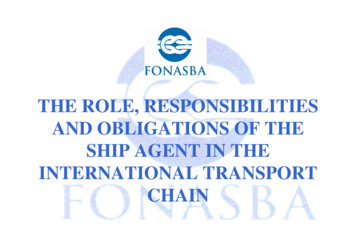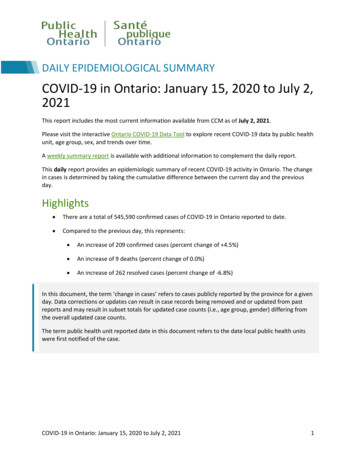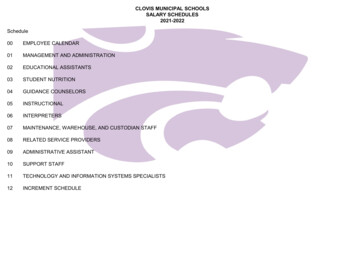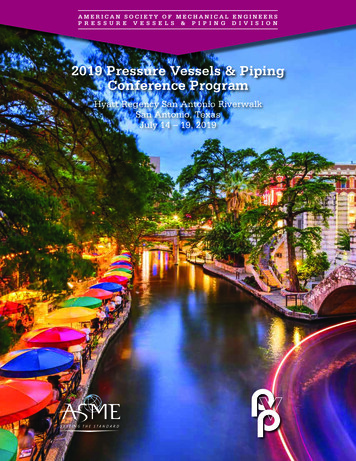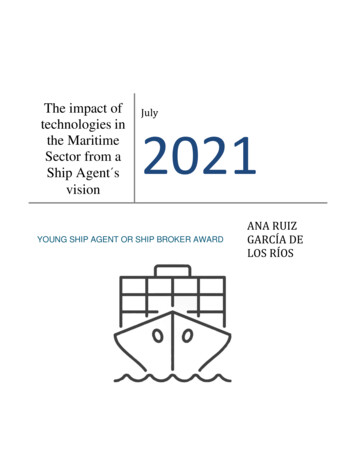
Transcription
The impact oftechnologies inthe MaritimeSector from aShip Agent svisionJuly2021YOUNG SHIP AGENT OR SHIP BROKER AWARDANA RUIZGARCÍA DELOS RÍOS
Disclaimer: This publication represents the views and opinions of the writer (Ana Ruiz García delos Ríos) as an individual only, drawn from general experience. The content of this publication doesnot represent the views and opinions of the writer’s employer Bergé, or any related organization.The writer shall not be held liable for consequences of actions taken by reader/s based on anyinformation, view or opinion provided, or implied by this publication.2
TABLE OF CONCEPTSABSTRACT. 4ABREVIATIONS . 5MARITIME TRANSPORTATION THRU HISTORY . 6AUTOMATION . 10BIG DATA. 13BLOCKCHAIN . 15SHIP AGENT . 18COVID-19 . 23HOW MY WORK AS A SHIP AGENT GOT AFFECTED BY COVID-19? . 26HOW ARE BIG DATA BLOCK CHAIN COVID 19 INFLUENCING THE SHIPAGENT ? . 28CONCLUSIONS . 31WORKS CITED . 333
ABSTRACTThe present project aims to determine and understand the impact of the new technologiesin themaritime sector, how automation and technologies have been changing maritime transporttransforming it into a more efficient industry that will directly impact the future of the sector,including the Ship Agency services. The benefits that they have brought regarding security, andefficiency.4
ABREVIATIONSBOE Boletín Oficial del Estado / State official newsletterETA Estimated time of ArrivalETS Estimated Time of SailingFONASBA The Federation of National Associations of ship Brokers and AgentsIMO International Maritime OrganizationIoT Internet of ThingsIPE Individual protection EquipmentISO International Organization for standardizationMI Maritime IndustrySBM Single Buoy mooringUAV Unmanned aerial vehiclesUN United NationsVPN Virtual Private Networks5
MARITIME TRANSPORTATION THROUGH HISTORYWhen we refer to maritime transportation we are talking about the shipment of goods (cargo) andpeople by sea and other kind of waterways. In order to enable maritime trade between tradingpartners, port operations are needed.The maritime transport has been historically at the latest regarding changes, however, nowadaysthey are facing new challenges. The new technologies and the automation are transforming frompolitics, to society to economy.Maritime transport throughout our evolution has played a crucial role, there is no doubt that theseaway is the oldest road in the world. First movement is dated when the Austronesians between3000- 1500 BC. (Rodrigue, 2020) The objective was trading and colonizing, thus producing thedevelopment of humanity.SPECIAL DATES ON THE MARITIME TRANSPORTATIONContainersNew ISO Regulation tostandardize the size,terminology andconstruction1956SupertankersNewly designed standardizedshipping container.START OF INTERMODALISM INSHIPPING19661968FullyAutomatedShipHigh Speed Catamarans1000 Passenger & 150 Cars65 MPH20131990201720202040?Current Largest Ship BuiltM/V HMM ALGECIRAS1st Internationalcontainer ship voyageFrom US to theNetherlandsMost advanced containerM/V MAERSK MC-KINNEYMOLLER18270 TEU24000 TEULargest Ship BuiltM/V OOCL UKA21413 TEU236 CONTAINERSFigure 1 Source: Ana Ruiz6
From this date to the present day, maritime transport has been growing since its beginningsit wasof vital importance in economic development and globalization.While we could go deeper into the subject, I would rather focus in the latest developmentof thecentury, which are truly related to the industrial revolutions. (Jeppesen, 2015)Figure 2 Source: MjolnerAs you can see in the above chart, the last century was all about technologies and development inthe maritime sector.Going back to 1956 when the intermodal shipping container was built, by Malcom Mclean(American Entrepreneur) which revolutionized shipping as how we know it nowadays. Firstcontainer ship was in 1956 its cargo were 58 containers and it went from Newark to Houston. Thecontainer by then was 20 foot long, 8 foot high and 8 foot wide. (Thompson, 2018).7
Moving forward we have the first international container ship voyage which took place from US toThe Netherlands and it was in 1966 and it carried 236 Containers (Nowadays it would beimpossibleto make such a trip with such a small quantity of containers).All of the above could had been a completely chaos, nevertheless it was not due to the ISO backto January of 1968 issued the first notice defining what a shipping container was, with terminology,dimensions and ratings. (ISO, 2020)While all this transformation of course more vessels were about to develop, at the beginning ofthe 90s, we could see high speed catamarans which were able to carry around 1000 passengersand 150 cars at a maximum speed of 65 MPH.Maersk did the next important movement that we could see, was the first Triple-E ultra largecontainers ship in 2013. The vessel, which was named after the late Maersk Mc-Kinney Moller(who passed awayin 2012), was able to carry up 18270 TEU, and was the largest ship in the worldwith 400 meter in length upon delivery (Maersk, 2020).Nowadays, as January of 2020 the latest and biggest ship containers is HMM Algeciras. It is 400meters length, and its bean is 61 meters. It has a capacity of 24.000 TEU.Sea lanes begin and end at ports. Around 3,000 ports participate in the commercial maritimeinterchange, that is the reason why they advance fast and with technification in the maritimetransport.It makes workers develop at the same speed, and both the carrier and the user mustknow the transport techniques, however it does not mean its workers are capable.8
This caught absolutely my attention, I have read something which has led me to think, it said asfollows “For developing countries ports, adapting to containerization was consequently a slowprocess as they generally had an abundant unskilled labor force available to them” (Nations, 2018).And my question is: how technology is supposed to be implemented equally worldwide, when wedo not have the same resources or available budgets?What I believe that it could be an answer is that in maritime transport, the adoption of noveltechnologieshas happened in gradually steps, but it does not mean that it has been done or thatwill be done equally.Looking worldwide, there is a need of investments in high-technological products which will helpinto the manufacturing productions to be able to increase efficiency. The world is nowadays moreconnected than ever with the global commerce, which is creating new jobs or even impacting inthe current ones.We, as a society, can do many things to stop the harmful effects of technology, like securingregulations.Workers as well, should use the new technology to organize. By working together with allstakeholders, we can ensure that the technologies make working and living life better.9
AUTOMATIONNowadays, technological advancements, including automation, are making transportation morecomplex and sophisticated, which undoubtedly will bring changes as well as opportunities.Vessels could be assisted by any type of technology which involves automation. With theimplementation of this technologies, we are looking at a big improvement regarding speed control,fuel saving or security.We have to keep in mind that sooner or later we will be talking about autonomous vessels, whichmeans that we will be having vessels without human supervision, nevertheless until then, vesselswill work autonomous however with human supervision.Some of the greater impact of the autonomous shipping will be as follows:1. The increase in operational safety of vessels: most of maritime accidents (75% 96%) are caused by human error as per Allianz Global Corporate & Specialty in itsGlobal Claims Review: Liability in Focus study, which means that introducing a fullautonomous or semi-autonomous vessel may help reducing these number ofaccidents.2. The reduction of crew size: as crew is reduced, that involves some fixed costs whichthe owner will safe, cost which will not be needed to be paid like the salary,insurance or even food supplies.3. The increasement in the efficiency on the energy, it is a matter of time that besideautonomous vessels we will be facing as well fully-electric and zero-emissionvessels, helping to reduce pollution all around the world.10
4. The increasement in data collection which will help at the same time regardingsupply chain connectivity. Autonomous ships will be able to collect voyage datathrough their “autonomous systems” making this information a way ofcommunication with supply partners about their shipments, or regardingoptimization of the future routes.Figure 3 Source: World Maritime University: Transport 2040 – Automation, Technology and Employment – The Future of WorkI have taken the above chart that I believe it makes a really good summary of which are thatfactors that could enable or delay the implementation or development of autonomous ships.Basically because of the current situation that we are living in the whole world regarding theCovid-19 pandemic, the costs of developing and deploy plus the lack of economy benefit that will11
bring, I believe that it will take more than expected, as we are going to face an economic recessionthat has nothing to do with the one experienced in 2008. Of course, the regulations andgovernance has to do a lot as well, and we can see the big impact that autonomous car lawregulations are having.Autonomous can be also applied to security, and I am talking about machines doing our jobs, forexample: drones or UAVs. Lately they have been used in so many fields like search and rescue,pollution monitoring and even delivering pieces, and so on. However, the biggest benefit has comefrom owners or charterers in order to optimize vessel s inspection, drones doing subaquaticinspections or even survey operations. Some classification societies, like DNV GL or Lloyd s Registerare already working with both UAVs and drones as their survey methodologies for some type ofvessels. While DNV GL confirms that they have carried out these surveys in different kind of vessellike oil tankers, chemical tankers, bulk carriers, ore carriers, or container carriers (GL, 2018) Lloyd sRegister does not specify regarding it.Figure 4 Source: DNV GL12
BIG DATAWhen talking about MI we refer to a convoluted system that requires a quick adaptation tochanging conditions and in which decision-making needs to take into account a large number ofparameters.While navigation systems become more advanced, there is a significant amount of shipperformance and navigation data generated. The Big Data analytics tools makes possible toanalyze these big amounts of data in order to gain the insight that supports decision-making.The automation of the processes and the introduction of “big data” in the maritime operationswill lead to the development of the engine monitoring, remote maintenance, and real-timeweather data and routing.This future technological approach of connectivity will aid shipowner to minimize cost bypreventing high-priced repairs and by enhancing operational performances.For example, the adoption of autonomous ships under human supervision is expected to reach 11to 17 per cent by 2040 (University, 2019) and the expectation is that these ships will be operatingin national and regional jurisdictions and specialized trades.Big data offers a boost in operations with ship calls, renewing port assets and ensuring optimumcyber-security. Additionally, big data is able to provide information in which solution providers,ports and agents along the supply chain can share.Big data remains “untapped” in the shipping industry, therefore there are huge opportunities forinnovation, usage, driving optimal performance and leveraging assets better (Siddiqui, 2016).13
What differentiates Big Data from any other type of information processing that the sector hasknown so far is the orientation towards results. It is not about working with how much more datathe better, but precisely choosing, among the wealth of data available, what are the indicatorsthat we must put in relation to solve our problems.Also, we have to keep in mind that not all non-traditional data is quantifiable and we can face toproblems such as changes in the weather or delays in the ports due to strikes that cannot be solvedwith GPS figures, nevertheless, Big Data can help find a solution using this information. Forexample, using the information provided by the GPS, a boat or truck can be redirected, helping toavoid delays in delivery times, loss of fuel, etc. When we make corrected use of Big Data, it enablesan intuitive decision to be made and a measurable and viable reality.Big Data is capable of including both internal and external information, and the combination ofboth is the main point that can produce an infinity of solutions that satisfy as many needs as thereare shipping companies and clients.The velocity of development of the Big Data will depend on the eagerness of the port and all thelogistics role players to share sensitive data, and the availability of the Port Authorities and theirgoverning bodies to promote or even set this transparency. Furthermore, the automation and realtime data handling between port players converge with the application of artificial intelligence andpredictive forecasting using big data collated from devices throughout the port, for example, the“Internet of Things”. (Nations, 2018)14
BLOCKCHAINTechnologically, blockchain is incipient, but it is growing very fast and there are already manytechnological solutions for the use of both public blockchain and private blockchain oriented tosupport applications in the corporate field, focusing on the privacy of information andperformance.Since 2017, there have been several blockchain initiatives carried out by liner shipping firms like(Maersk, Hyundai Merchant Marine, Bloklab.) (Comben, 2019) which have been exploringblockchain and its evidence regarding proliferating of concept in all sectors, seeking thematerialization of the advantages of the paradigm in applications on real use cases.4Figure 5 Source: CBInsights15
The field of logistics and transport is not far away to the development of initiatives aroundblockchain and, although it is currently in an initial phase regarding other sectors, like Banking &Finance, Insurance, or healthcare, we begin to observe a relevant activity and the expectation isthat it will increase in the short term.As of today, they are already being carried out various projects concerning international trade,ground transportation of goods, traceability of product.The potential impact of blockchain requires all sector performers in a position in this regard, aswell as a rigorous assessment of threats and opportunities that you can introduce, in order toavoid staying on the sidelines in business transformation, being able to respond to new modelsthat may emerge and define a strategic approach that allow to obtain competitive advantages.Albeit the current changes from my point of view, industry needs to push towards the digitalrevolution it requires in order to achieve its maximum. It is quite obvious that industry moves bycost, and legal stipulations that need to be accomplished.I believe that the industry s lack of knowledge regarding blockchain s possibilities might be themain reason for its slow endorsement, which hopefully will change in a short period of time.Technology is capable of connecting the supply chain in a more efficient way, leading to exchangeinformation which has been proved, and also by decreasing operational cost betweenintermediaries and last but not least, increasing security.Basically, the main problem in order to allow innovation are the “costs”, which are capable of beingan empowerment and an impediment at the same time, being the element able to promoteindustry s readiness of blockchain application.16
The right use of blockchain promises to increment the efficiency as well as the productivity in thelogistics, customs operations, the finance of the commerce and the payments.How about if we mix the IoT and the blockchain? Cost could be reduced drastically to the companies which secure cargo of export andimport. Identify more precisely the timing and responsibility of insurable events. Speed up payments.Example: If a container carries thermo-sensitive goods, an installed IoT device could be able totransmit to a blockchain the moment and location of the container when the temperature deviatesfrom the prescribed range and for how long it has been. Moreover, adding a smart contract in theblockchain, could inform the insurance company of the goods lost because of the temperature andspeed up the payment of its lost to the importer or exporter even in the goods have not arrived yet,or even make a backup plan.Nothing but good can come up from applying the blockchain to the maritime sector, or internationalcommerce.17
SHIP AGENTThe figure of the Ship Agent arises from the need of the shipowner to resort to certain people whocollaborate with him during the stay of the vessel in the port. We are terrestrial collaborators of theshipping company, terrestrial auxiliaries. We develop or carry out commercial functions that couldnot be attended by the captain or the shipowner. The appearance of these agents is locatedat thebeginning of the XIX century5.The article 319 of the Spanish Maritime Navigation Law defines the Ship Agent as follows: Ship Agentis understood as the natural or legal person in charge, by account of the shipowner, in whose nameand representation he acts, of the efforts material and legal necessary for clearance and otherattentions to the ship in port (BOE, 2019).Therefore, it is the natural or legal person duly registered in the organizations of the Administration,which attends to the needs of ships during their stay in the country's port / s wherethe Ship Agent slives. Wherever a ship goes in the world, a figure is necessary of the consignee agent, as well asdescribed in the Maritime Transport Manual (Montori, Escribano and Martínez, 2015).There are three kind of Ship Agents: When is acting on behalf of the charterer, is called the “Ship's agent”. When the charterer does not trust the Agent chosen, and charterer nominated as we will be“Owners Protecting Agent”. When acting on behalf of the owner of the ship it is called "Husbandry Agent".5According to Francisco Carlos López Rueda, expert in commercial law and maritime law, “although we cannot placetemporarily, in an exact way, its appearance in maritime traffic, its physiognomy is well defined already at thebeginning 19th century18
The Ship Agent is in charge of intermediating and representing the ship in port on behalf of theshipowner, that means being in charge of the invoices for tariffs or other concepts which areoriginated by the stay of the vessel in the port, are practiced by the Port Authority or HarbourMaster. In both cases the shipowner or the charterer of the ship is obliged to pay, usually beforevessel s arrival.Some of the functions that the ship Agent develops are: Guarantee berthing and undocking services: requesting and updating pilotage, towing andmooring regarding vessel s ETA and ETS. Administrative documents with the different organisms and authorities: Port Authority,Harbour Master, Health, Customs, Border Police. Custom clearance import / export. Preparation of all required ship documentation of the entry and exit authorization ("ShipClearance") of the ship at the port of call. Arranging with the terminal or stevedore how to proceed with the Loading / Unloadingoperations. Delivery and collection of documentation required by the Port Authority, Harbour Masterand Customs once the ship is docked or anchored (when using the SBM single pointmooring) Keep duly informed all parties involved regarding arrival and departure previsions. Monitoring of port operations. Arrange the supply of things or services requested by Master or Shipowner.One of the things which I love the most about my job, is going on board to different vessels, from19
Car-carriers, to tankers, to bulk carriers, to passengers’ ships. All of them, with their particularities,have taught me something special about each kind of vessel.When I board the car-carriers through the ramp, I am in the floor 5th already and they are usually13 floors tall.Curious fact: the ceiling is able to adapt to the kind of cargo that they have, this way, they canoptimize and have more available spots for other cargo.Figure 6 Source: Ana RuizFigure 7 Source: Ana RuizAbove pictures belong to a car-carrier vessels, which are regular ships, berthing in a normal dock,but then, we have the most interesting vessels, that are my favorites, the tanks that goes to theSBM.These vessels which go to the SBM are moored to a buoy in the middle of the water, so there isnot a dock to embark or disembark. There is a launch/tender which will bring you to the vessel andthen you basically have to jump from the launch to the Pilot ladder. If you are lucky, you do nothave to change to the side ladder latter on.Usually, the vessels which go to the SBM the operation that they do is discharging through a20
pipeline which goes under the water to the main factory.Another curious fact is that when the vessel arrives, as it is full loaded and comes to discharge, thehigh is not usually too big between 10-14 meters, but, when the operations are completed andthe vessel is empty or half empty, you will have to climb sometimes up to 25 meters high.Figure 8 Source: Ana Ruiz Pilot ladderFigure 9 Source: Ana RuizFigure 10 Source: Ana Ruiz Pilot ladder side ladderAs ship Agent who is in the middle of the entire maritime logistics transport chain is quite complexto understand the different functions that we develop. Working in a maritime agency has leaded21
me to understand the requirements in the maritime traffic, such as the speed of the trips and thecosts of the stays of the ship in the port, and why such an auxiliary figure is so needed in order tohelp the captain as well as to accomplish those requirements as well as the shipowner’s ones. Ibelieve that there are many things which can be improved in this sector, nevertheless thosethoughts will be explained in the section of how the big data with the blockchain could influencethe ship agency.Figure 11 Source: Ana Ruiz22
As the current situation that we are living in the whole world, I have decided to add a section calledCOVID-19 as we all have been affected in some way or another by this virus.COVID-19As a result of this virus, countries have done an intense amount of research resulting in dataanalysis, models, dashboards being created on a daily basis in order to help better understand thecurrent impact, and visualizations of how this pandemic may have happened, and how this maybe affecting near-term future.As expected, the maritime sector has been also affected in a big way. At the beginning of thispandemic, ironically some ports in Chinahave had quarantining vessels for up to 14 days before theyenter the destination port, dependingon whether their last port visit was in an infected country(Japan, South Korea, Iran, France, Germany, Spain, Italy, U.S., and Singapore) (Alfred Cang, 2020).All these quarantining vessels willbring a tremendous impact on global commerce attributable tovessels being held for up to 14 days before being able to exchange their goods. Obviously, the riskwhich these vessels were holdingwas defined by the location of the last port visited and if is aninfected region.Figure 12 Source: Puertos del Estado23
Covid-19 has highly influenced the oil price in combination with other things of course, as the pricewas so low that it is the first time in history you got money to buy a barrel (Fred Pals, 2020)approximately 70% of all oil warehouses worldwide were full (Reed, 2020) , so, one option that wecould think about will be about motor-tank vessels could be used as storage rather than transportpossibility.We should also take a look at the Seafarers, in march of 2020 the IMO joined many other industryrepresentatives in calling for seafarers and maritime personnel to be recognized as key workersand therefore to be exempted from travel bans. In its letter to global governments, theorganization also highlighted the importance of keeping ports open and supporting the supplychain.This letter which confirms that, in this time of global crisis, it was more important than ever tokeep supply chains open and maritime trade, transport and services moving. It calls ongovernments around the world to develop their policies and measures to protect public healthand address COVID-19, without introducing obstacles to ship and port operations, including themovement of seafarers and marine personnel. Governments and national authorities werestrongly encouraged to ensure that all visiting commercial ships continue to have access to berthsin port and terminals(International Maritime Organization, 2020).The situation in Spain regarding COVID-19 was not good, therefore there have been manyrestrictions regarding the movement of seafarers and how to proceed with them, nevertheless allthis situation has improved one thing from my point of view, which is to work telematically.24
Last year in Europe, we had the lowest matriculation of new cars ever, European AutomobileManufacturers Association says that in March the registration of passenger cars decreased -55%meanwhile the registration of commercial vehicles was reduced a 47,3%, this is another sectorwhich has been hit by Covid-19 which involves a chain of different supplies.Having in mind all of the above, looking at short-term, jobs that have been influenced are speciallythe producing companies - which focus for example on automotive industry (looking at the aboveinformation) – they have completely stopped producing cars, trucks, busses, agricultural machinesand so on - so all transport modes which offer these transports have been mostly stopped, likecar-carrier vessels.Consequently, all this can only develop to one thing, which is the unemployment. In general thehigh unemployment rate (Last year, Spain has the second biggest one in Europe after Greece(Expansion newspaper, 2021) and the short-term work (for example in Austria you earn only 80%of your salary,but it depends – as in every country is different) lead people to hold their savings so even thougheverything opens again and retail markets open completely - people will not bewilling to expendtheir money if it is not highly necessary, which means that a “trade opening” willnot stimulates the economy as wished by everyone but only for things which have a highestpriority like food, medicines (which are always both available) – also products that can make yourhome and gardennicer - as we were in quarantine at home and have time to refurbish things byour self instead of hiring someone to do it - so artisans will also feel a decrease in their work.25
HOW MY WORK AS A SHIP AGENT GOT AFFECTED BY COVID-19?From one day to the other, everyone’s lives changed completely. Personally, mine changed everysingle routine I had until March 14th when we got confined in Spain. From not going to the office,to virtual meeting through "teams" every day, to surveyors calls at midnight, to even more emailsthan before, to new Covid-19 procedures at the office, at the jetties, on board However, if something good has this job, it s how rewarding it is connecting with people from allover the world, not even a virus could stop that.Yes, we as Ship Agent, have many tasks, and when a vessel has a potential positive case on board,it can only bring more casuistry to the port call. From talking to all Port Authorities to even thesanitary minister (which will indicate us how to proceed). Also, we will need more documents thatusual like medical logbook, declaration of maritime health, Onboard Health Certificate with TestReport Form, Certificate of Free Practique issued by the Sanitary Authority of the port ofdeparture.Vessels have their own Covid procedure on board, when boarding generally they take yourtemperature, make you fill up a document with some questions about your health situation andinform you to used disinfectant gel, before going inside.Also my IPE got affected, I do not need only to wear my helmet, shoes and vest, now, it iscompletely mandatory to wear Mask (currently it is compulsory to wear it).26
Below, you can see two photos of me, doing my job, the difference is that in the first there was noCovid. In the second one, there is Covid, an
vision July 2021 YOUNG SHIP AGENT OR SHIP BROKER AWARD ANA RUIZ GARCÍA DE . and was the largest ship in the world with 400 meter in length upon delivery (Maersk, 2020). Nowadays, as January of 2020 the latest and biggest ship containers is HMM Algeciras. It is 400 meters length, and its bean is 61 meters. It has a capacity of 24.000 TEU.

